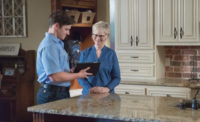Every year, Lotus House — a women's shelter funded by the Sundari Foundation — houses over 500 women and children who are experiencing homelessness. The shelter is located in the Overtown section of Miami in a three-year-old, state-of-the-art building. It provides mini apartments, education, medical care, counseling, job training, and job placement, helping occupants achieve self-sufficiency and transition to new homes.
When the COVID-19 pandemic hit, the Lotus House team started researching ways to combat the virus and keep their occupants safe while indoors. After investigating recommendations from the CDC and ASHRAE, they settled on ultraviolet germicidal irradiation, which ASHRAE had recommended back in April 2020.
Katy Roth, the director at Lotus House, selected Sanuvox Technologies to supply IAQ equipment for the project. The company has been producing these products for 25 years.
“Our technology was actually tested by the government back during the Anthrax scare, and we were recommended by the EPA and Homeland Security for our technology to be used against biological contaminants,” said Bob Pietrangelo, vice president of sales – Southeast U.S. at Sanuvox. “Our technology is also one of the technologies recommended by ASHRAE.”

AIR CLEANERS: The new UV-C equipment is keeping air safe for Lotus House residents during the pandemic and beyond.
At Lotus House, Roth started with hospital-grade surface disinfection. The team at Lotus House sanitized every common area each night with four hospital-grade UV-C towers. The next phase was installing several Sanuvox air purification systems. The installation team used a combination of 18 R Max residential units as well as BioWall and Quattro commercial air purification systems.
Pietrangelo said what makes the company’s UV-C system stand out is the positioning of the lamps.
“This is all in-duct purification,” Pietrangelo explained. “What Sanuvox did is they put their lamps parallel with airflow, so the biological contaminants are in line with the UV-C lamp longer. That's how we kill everything that goes through it.”
Due to these improvements, every common area is now being disinfected and the air made safe to breathe.
“Lotus House is now the safest place in Miami to breathe air indoors,” said Pietrangelo.
The investment in UV-C IAQ equipment will pay off for Lotus House long after the pandemic is a thing of the past.
“People are installing it because of the virus,” he said. “But the benefit they're going to get in the long run is decreased illness from other things that are spread in the air. Any kind of biological contaminant that gets disseminated through your ductwork … it's going to be inactivated so it can't infect someone once it goes through. So even after this virus is over, things like the flu, tuberculosis, and allergens are not going to affect people anywhere near as much as they would in the past, which is going to drastically save them on healthcare costs. The healthcare costs alone will more than pay for their products.”
Health isn’t the only benefit that occupants will enjoy. There’s a comfort aspect, too.
“In addition to keeping them safe from contaminants, we also have part of our device that does odor removal,” Pietrangelo said. “We use what's called a cobalt catalyst that that assists us in the removal of odors. We're also eliminating the cigarette odors, cooking odors, pet odors, and stuff like that.”
The work at Lotus House was paid for through a grant, and Roth is currently in the process of securing funding to install air purification units into all the 48 living quarters, as well as to acquire Sanuvair S300 units from Sanuvox for the laundry rooms. The Sanuvair S300 unit is a combination of UV-C purification with multi-level filtration, including HEPA, that the CDC is recommending for school reopening.
“Lotus House deserves a lot of credit for the care they've taken to protect its residents,” said Pietrangelo. “They did everything that science offers to combat this virus. Their actions will pay tenfold when the health-saving costs are factored in by reducing or eliminating almost every other biological contaminant that floats into their building.”








